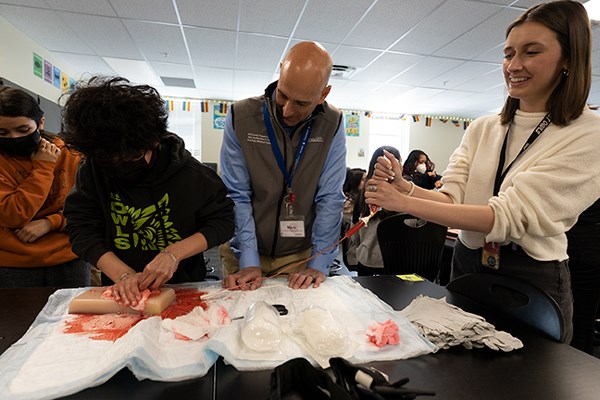Editor’s note: This story was originally published by The Sentinel and was shared via AP StoryShare.
AURORA: It’s not the kind of thing you would normally expect to see in a classroom, but Aurora Science and Tech isn’t a normal school. On Monday morning, a classroom of eighth graders practiced emergency first aid on fake arms as part of a hands-on lesson delivered by nurses at the Anschutz Medical Campus about how to stop bleeding.
It’s the kind of interactive education that the middle school prides itself on as part of its mission to make careers in STEM and healthcare fields tangible for students. Starting next year the school will be accepting ninth graders as well as part of its four-year expansion into becoming a 6-12 school.
Aurora Science and Tech (AST) is a charter school run by the Denver School of Science and Technology (DSST) network in the Aurora Public Schools district, and is physically located on the campus of the University of Colorado Anschutz Medical Campus.
It’s one of only six schools in the nation located on a major medical campus.
The school launched in 2019 as a grades sixth-through-eighth school, and over the next four years it will be adding a grade every year to build out its high-school program. As part of the expansion it will break ground in about a month on a new building, which is scheduled to be complete in the fall of 2023.
The middle-school students will then be transferred to the new building, and the high school will be run out of the existing structure on Scranton Street.
The school intends for the AST middle school to be a feeder into the high school program, but students will be able to enter at the high school level as well.
Admission is conducted by a lottery system, with students who live in the area directly surrounding the campus and then students living inside the APS boundary given first and second priority.
The middle school has roughly 450 students. At full capacity the high school will have 600 to 700 students, said Kryszelda Mendoza, who will serve as director of the high school. The district is enrolling 160 students into its ninth-grade class, with 145 spots going to current AST eighth graders.
One of those students is eighth grader Ivan Shigeta, who is looking forward to being a part of AST’s inaugural freshman class in the fall. She said she likes the school because of its unique learning environment and inclusive culture.
At AST “I’m always able to be who I am,” Shigeta said.
Construction of the new building will cost $16 million, said Jill Ruiter, executive director of the APS Foundation. The project is a public-private partnership, with some of the funding coming from the 2016 Aurora bond election that created the school and some coming from philanthropic donors.
“The community is rallying around this idea of STEM education,” Ruiter said.
UCHealth contributed $250,000 to the project, and the school plans to work closely with faculty from Anschutz who will provide guest lectures and give students the opportunity to visit many different parts of the hospital and see how the things they’re learning in the classroom could translate into a career.
“The thing that we’re most excited about is our ninth graders will be old enough to participate in some of the labs and enter some of the facilities that they were too young to in sixth grade, and so I really want to make this partnership dynamic so that kids are experiencing science and getting to see it on campus,” Mendoza said.
The high school will have a particularly strong focus on the biosciences, with the goal of helping students prepare for higher education in the healthcare field or giving them the skills they need to enter the industry right after they graduate, such as by allowing them to get a certificate in phlebotomy while still in high school.
UCHealth’s donation helped to create the school’s science and innovation lab, where the students had their “stop the bleed” lesson. The lab will be used for a variety of hands-on activities and experiments directed by UCHealth employees.
Dr. Jean Kutner, Chief Medical Officer at the University of Colorado Hospital and DSST school board member, said that hospital faculty are “so excited” to partner with the school.
With the healthcare industry currently experiencing a nationwide shortage of workers, Kutner said she hopes that the school will help inspire students to pursue a career in the field.
APS Superintendent Rico Munn said the school responds to a desire from the Aurora community for a closer partnership with CU Anschutz and more workforce-oriented educational opportunities.
“Having our kids physically on the campus is important because they see it as a reality and a real option in their community,” he said.


.jpg;w=120;h=80;mode=crop)
